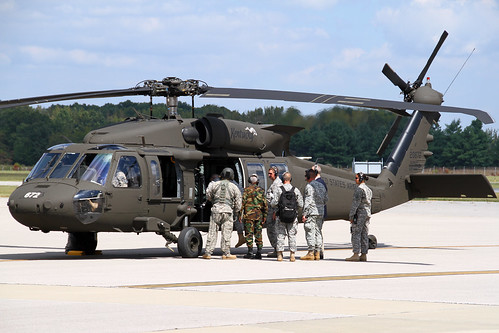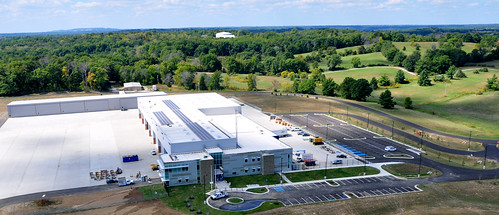Story and photos by: Spc. Abe Morlu, 133rd Mobile Public Affairs Detachment
[caption id="" align="alignleft" width="383"]

Chief Warrant Officer Wallace Kand, a UH-60 Black Hawk pilot, performs preflight checks on the helicopter prior to a training mission at the Boone National Guard Center in Frankfort, Ky., Sept. 23, 2015. These Kentucky Guard pilots train as much as they can to stay current and be ever ready should they be called upon. U.S. Army National Guard photo by Spc. Abe Morlu
FRANKFORT, Ky. --In its ongoing mission to support both state and federal missions, the Kentucky National Guard has added a new flight facility at the Boone National Guard Center. Along with the facility is a fleet of 16 new helicopters as well.
To see all the photos, please click HERE.
Construction is coming to a close on the new hangar to house the 20 aircraft used by the KYNG. That fleet consists of ten brand-new UH-60M Blackhawks, six two-year-old UH-72A Lakotas, three UH-60L (older model) Blackhawks, and one C-12 (King Air) Huron Airplane. The C-12 is currently housed in a hangar at the Capital City Airport leased by the KYNG.
“For the first time since 1983, when the Kentucky Guard was the first Guard unit to receive Blackhawks, all the aircraft will be able to fit in one building,” said Chief Warrant Officer Gerald Carroll, aviation safety officer for the Army Aviation Support Facility. The original hangar was constructed in 1972, and housed both the UH-1 Iroquois and OH-58 Kiowa.
“These were much smaller aircraft so was no problem storing them in the hangar,” according to Carroll.
Once the UH-60L arrived in 1983 that was no longer the case. Aircraft had to be left outside due to the lack of hangar space. “It is not ideal to store the craft outside because they are susceptible to damage from Mother Nature,” said Staff Sgt. Daryl Casey, a crew chief at the AASF.
Corrosion and lightning strikes are the nemesis of aircraft. They can cause millions of dollars of damages. “Lightning can damage bearings as well as the hull of the craft on its escape,” said Chief Warrant Officer Stephanie Motley, one of the instructor pilots for the new UH-60 mike model aircraft.
[caption id="" align="alignright" width="380"]

Kentucky Guardsmen and members of the Djibouti military board a UH-60M Blackhawk at Fort Knox, Ky., Sept. 16, 2015. During the Djibouti delegation's visit to Kentucky, the new Blackhawks provided aerial tours of Kentucky Guard facilities as part of the National Guard's State Partnership Program. (U.S. Army National Guard photo by Staff Sgt. Scott Raymond)
Not only will the new facility keep the aircraft out of the elements saving the Kentucky Guard from high costs in maintenance and repair, but it will also save energy consumption. The new facility will allow more natural light to enter during the day, relieving the reliance on electric lighting to preform daily tasks. This change directly eased the budget strains created by high energy costs.
Should there not be enough sunlight to illuminate the hangar, electric lighting can be used. However the electricity to turn the lights on does not come from the local power company. It is produced by the solar array installed on the roof of the hangar.
Gone are the days of heating the hangar with vents high up on the ceiling. The floors of the new hangar use geothermal energy to heat itself. They bring the heat closer to the crew and not inefficiently blowing down from above as hot air rises.
“The new technologies and availability of necessary outlets, allow us to better maintain the new Mikes,” said Chief Warrant Officer Stuart Lindfors,” a UH-60 instructor pilot.
Servicing the new helicopters is the same as its predecessor however, there are a few new parts alien to the UH-60L which require maintenance. The new model has new systems such as a rotor brake, said Casey.
“It’s like working on a 2000 Ford truck versus working on a 2015 Ford truck,” Casey said. “It pretty much works the same but has a few extra bells and whistles.”
[caption id="" align="alignleft" width="407"]

An overhead view of the new Army Aviation Support Facility at the Boone National Guard Center in Frankfort, Ky., Sept. 23, 2015. The new AASF is spacious enough for all the aircraft to be stored indoors, and it is also very energy efficient using solar and other natural power sources. (U.S. Army National Guard photo by Spc. Abe Morlu)
One of those bells and whistles is the hover hold function present in the new model. It allows the pilot to hold a set altitude and position with no input form the pilot. No more having to fight with external forces to hold position as in the older model.
“They are both great aircraft but, the new technology helps us better use our skills learned in training,” said Chief Warrant Officer Wallace Kand, a recent graduate of the UH-60M flight course.
“No longer will we envy the equipment and facilities of other states,” said Carroll. “Kentucky is a leader when it comes to Army aviation.”
Spirits are high with anticipation of beginning operations in the new facility as well. It will be the first time in almost 40 years being able to house and maintain all the aircraft indoors.
“We have accomplished so much with our antiquated equipment and facilities over the years," said Col. Brian Abney, commander of the AASF. "I cannot wait to see what we will produce with the new facilities.”